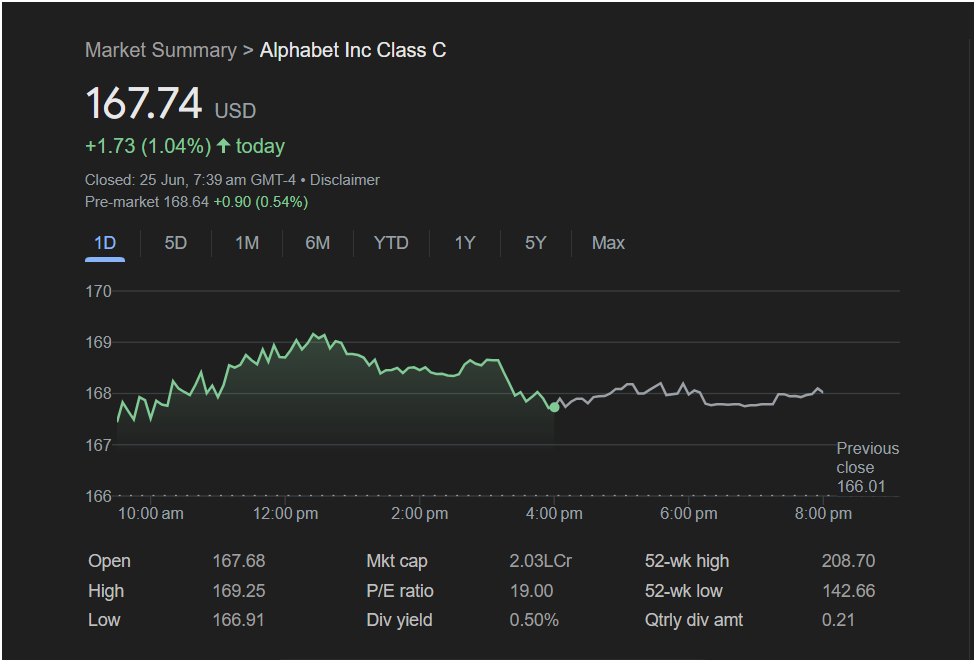Alphabet Stock Shows Bullish Signs: What Tuesday’s Gains and Pre-Market Action Mean for Investors

New York, NY – Alphabet Inc. Class C (GOOG) stock demonstrated significant strength in its latest trading session, and early indicators suggest this positive momentum could carry into the next market open. For traders and investors closely watching the tech giant, a detailed look at the numbers reveals a bullish short-term outlook, though key resistance levels are also in play.
Tuesday’s Trading Recap
The Alphabet stock concluded the trading day on Tuesday, June 25th, at
1.73, or 1.04%, for the day, signaling strong investor confidence. The performance outpaced the previous day’s close of $166.01, establishing a clear upward trend.
A closer look at the intraday chart shows a dynamic session:
-
Open: The stock opened at $167.68.
-
Intraday High: It rallied to a peak of $169.25 around midday, showing robust buying pressure.
-
Intraday Low: The lowest point was $166.91, indicating that the stock found strong support and did not fall below the previous day’s close.
While the stock pulled back from its high in the afternoon, it successfully held onto the majority of its gains, closing strong. This pattern often indicates that while some profit-taking occurred, the underlying sentiment remains positive.
The Critical Pre-Market Signal
Perhaps the most crucial piece of information for predicting the next session’s open is the pre-market activity. As of the report, Alphabet stock was trading at
0.90 (0.54%) after the market closed.
This after-hours strength is a powerful indicator that positive sentiment is spilling over. It suggests that the stock is likely to open higher in the next trading session, potentially gapping up from its previous close.
Key Financial Metrics for Traders
To get a complete picture, a trader must consider the fundamental data provided:
-
Valuation (P/E Ratio): At 19.00, Alphabet’s Price-to-Earnings ratio is moderate for a leading technology company, suggesting it is not excessively overvalued compared to its earnings.
-
Market Position (52-Week Range): The stock is trading between its 52-week low of $142.66 and its high of $208.70. At its current price, it has significant room to run before re-testing its all-time highs.
-
Shareholder Value (Dividend): With a dividend yield of 0.50% and a quarterly dividend amount of $0.21, Alphabet is now providing a small but steady income stream to its investors, a factor that can attract a broader base of buyers.
-
Market Capitalization: The figure “2.03L Cr” points to Alphabet’s massive scale as one of the world’s largest companies, with a market cap exceeding $2 trillion.
Outlook: Is It Time to Invest?
Based on the available data, the short-term outlook for Alphabet stock is bullish. The combination of a strong daily close, a healthy trading range, and positive pre-market momentum points towards a higher open and potential for further gains in the upcoming session.
For a Trader:
The pre-market jump to $168.64 is a clear signal of strength. The key level to watch will be the previous day’s high of $169.25. If the stock can break through and hold above this level, it could trigger further buying and a move towards the $170 mark.
For an Investor:
The fundamentals remain solid. The recent introduction of a dividend and a reasonable P/E ratio make the stock attractive for long-term holding. The current price is a considerable distance from the 52-week high, suggesting potential upside for those willing to invest for the long haul.
In conclusion, all immediate signs from the provided data point to continued upward momentum for Alphabet stock. While market conditions can change, the strong close on Tuesday coupled with positive pre-market trading provides a compelling reason for optimism heading into the next trading day.
Disclaimer: This article is for informational purposes only and is based on the data provided in the image. It does not constitute financial advice. All investors should conduct their own research and consult with a financial professional before making any investment decisions.


